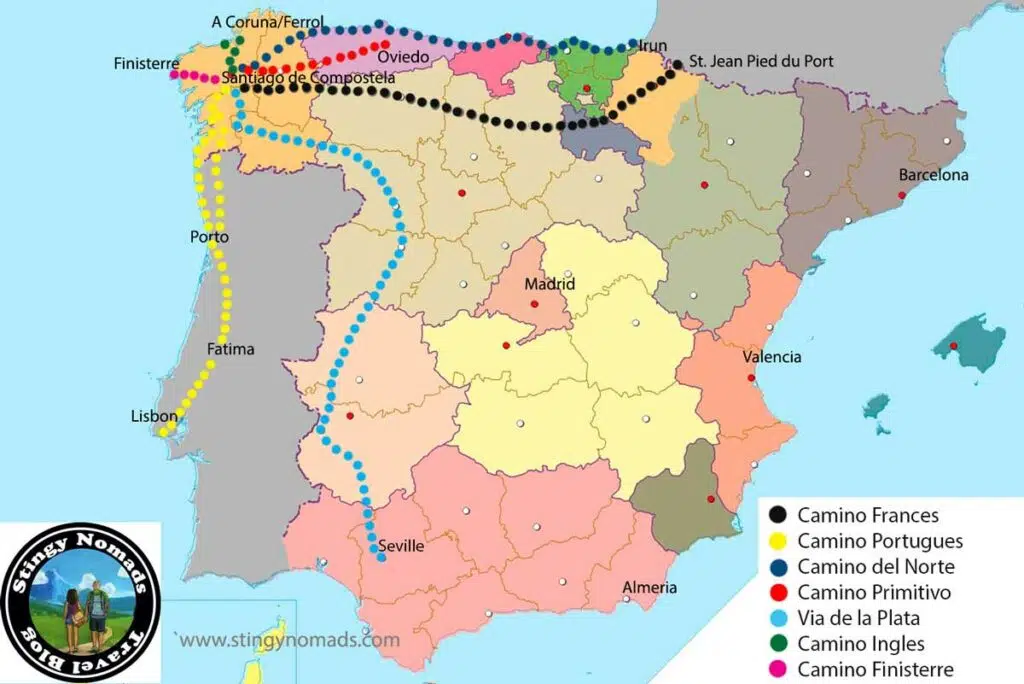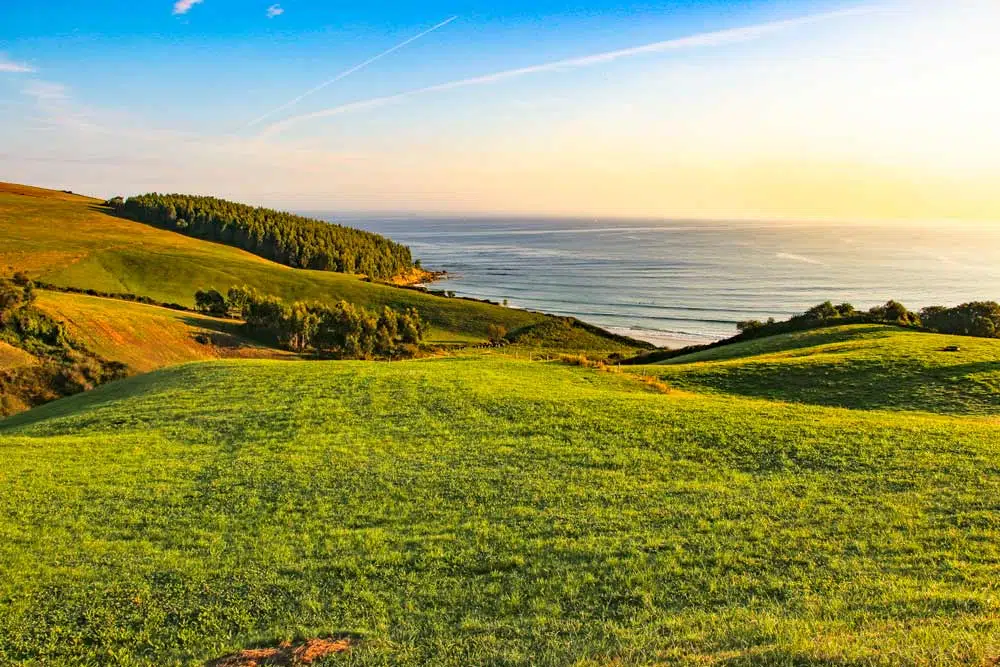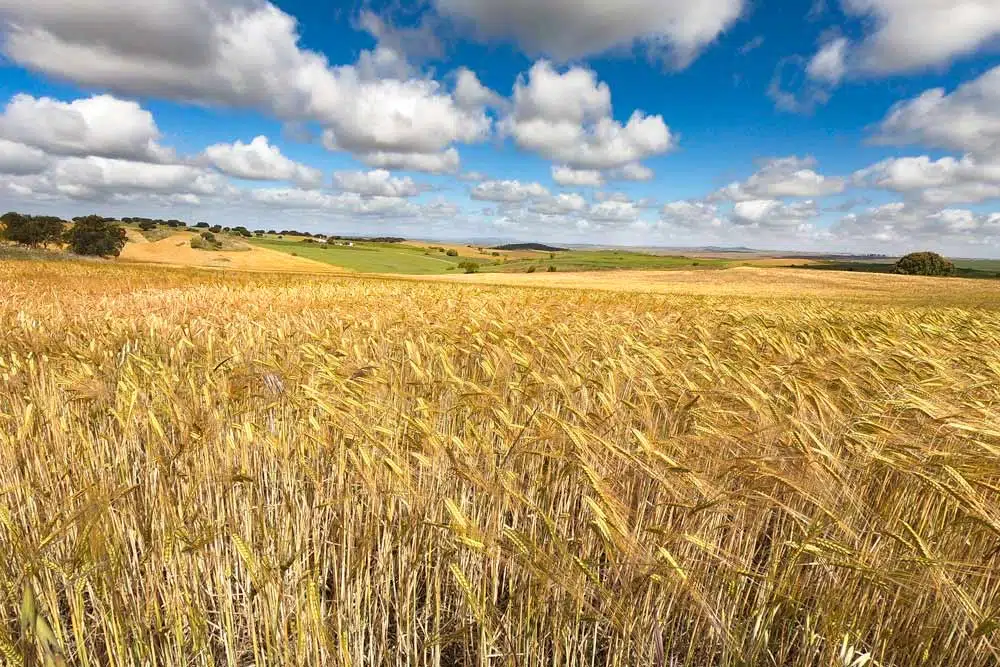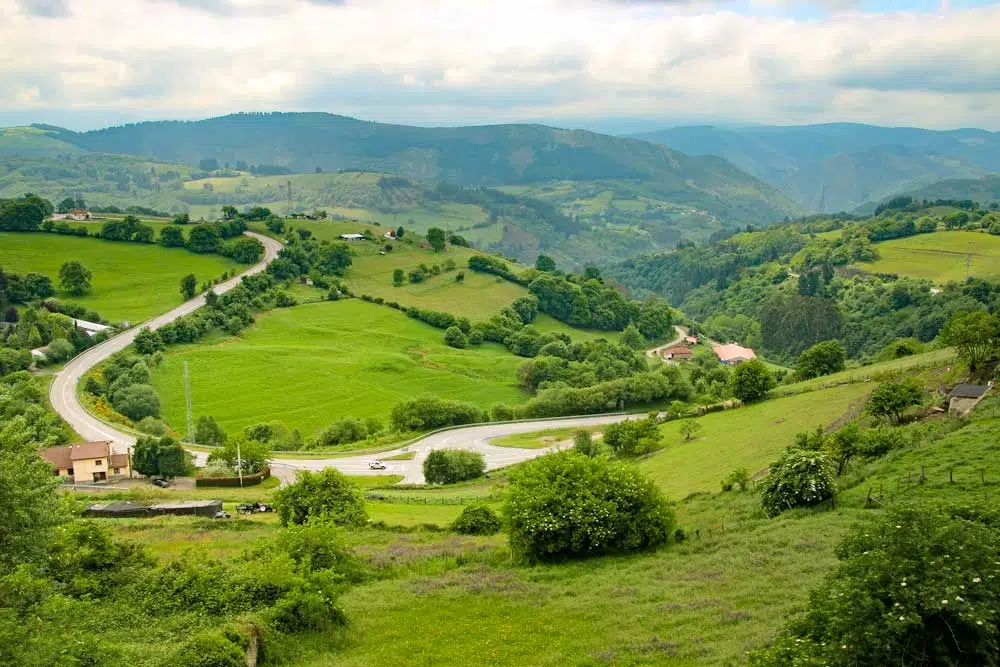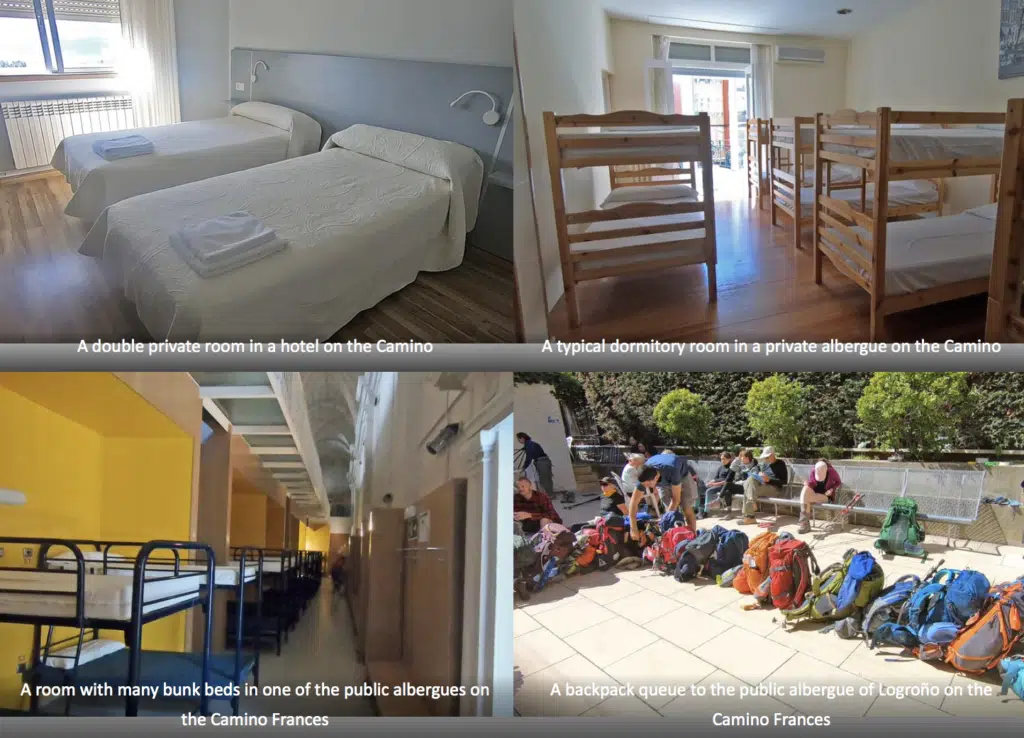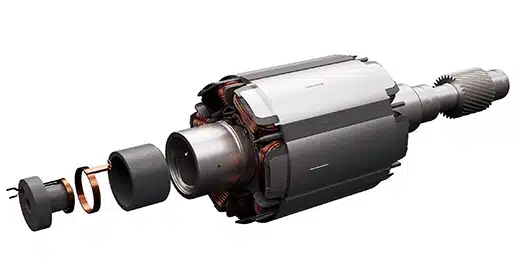Walking the Camino de Santiago is a great experience, the best thing about the Camino is that anybody can do it…
you don’t have to be an experienced hiker or super athlete to walk it. Camino de Santiago has many different route options from a short 120 km walk to the long and challenging 800 km and even 1000 km routes depending on how much time you have, what you want to see, and how far you can walk you can choose any of the existing routes. I must warn you the Camino might be addictive, many people come back again and again after completing their first Camino route. You can find many Camino posts on our Camino de Santiago page. We tried to create the best resource that pilgrims can use to plan their journey.
by the time of writing this post we walked seven different Camino routes:
- Portuguese Camino (from Lisbon) – May 2018
- Camino Primitivo – June 2018
- Camino del Norte – October 2018
- Camino Finisterre-Muxía – November 2018
- Vía de la Plata (part of it, 214 km from Seville to Mérida) – April 2019
- Camino Inglés – May 2019
- Camino Francés – September 2019
- Camino de San Salvador – September 2022
We couldn’t do any Camino routes in 2020 due to the pandemic. In 2021 our daughter was born we didn’t get a chance to walk. This year we’re planning to restart our Camino journey. We’re going to walk the Portuguese Camino again this time with our daughter. Now when we live in Portugal we can spend even more time on the Camino de Santiago.
What is the Camino de Santiago?
The Camino de Santiago or the Way of Saint James is a pilgrimage route to Santiago de Compostela, a city in Galicia (Spain). It’s believed that in the cathedral of Santiago the body of the apostle Saint James was buried. The history of the Camino de Santiago goes back to the 9th century when Spanish King Alfonso II completed the first-ever pilgrimage to Santiago de Compostela from Oviedo. Nowadays this route is known as the Camino Primitivo. The Camino de Santiago is not a single route but a network of routes that start in different cities, mainly in Spain (some in Portugal and France), and finish in Santiago.
Different routes of the Camino de Santiago
What is the Camino de Santiago?
The Camino de Santiago or the Way of Saint James is a pilgrimage route to Santiago de Compostela, a city in Galicia (Spain). It’s believed that in the cathedral of Santiago the body of the apostle Saint James was buried. The history of the Camino de Santiago goes back to the 9th century when Spanish King Alfonso II completed the first-ever pilgrimage to Santiago de Compostela from Oviedo. Nowadays this route is known as the Camino Primitivo. The Camino de Santiago is not a single route but a network of routes that start in different cities, mainly in Spain (some in Portugal and France), and finish in Santiago.
Camino de Santiago routes
As I mentioned above the Camino de Santiago is not a single route, as some people think referring to the most popular route – Camino Frances, but a network of routes. In fact, you can start walking towards Santiago from anywhere in Europe and it’ll be the Camino but outside the established Camino routes it will be difficult to find an infrastructure for pilgrims; accommodation, route markings, etc.
There are several established Camino routes, they all start in different cities and end in Santiago de Compostela;
Camino Frances (the French Way) – the most popular route, about 55% of all pilgrims choose this Camino. The French route starts in Saint Jean Pied de Port, a French town near the border with Spain. Total distance 790 km. If you’re planning to complete the entire route read our post on how to get to St.Jean Pied de Port. 50% of pilgrims who complete this route walk only the last 100 km from Sarria. The last 100 kilometers to Santiago on any Camino is a required minimum for getting the Compostela (the Certificate of the Camino de Santiago).
Camino Portugues (the Portuguese Way) – the second popular route. It starts in Lisbon but most people walk it from Porto. Total distance from Lisbon – 616 km, from Porto 260 km or 280 km, depending on the route you take. There are two different routes from Porto; the Coastal route, it’s walked only by 4% of the pilgrims, and the Central route, which is walked by 20% of the pilgrims. The Coastal Route goes along the coast from Porto to Vigo, the Central Route goes inland all the way to Santiago.
Camino del Norte (the Northern Way) – this route is growing in popularity, In 2019 6% of all pilgrims who arrived in Santiago completed this Camino. The Northern Way is a great alternative to the French Camino. I’ve walked both and liked the scenery on the Camino del Norte more. The route starts in Irún, a small Spanish town on the border with France. The total distance of the Camino is 825 km.
Camino Primitivo (the Original Way) – one of the lesser walked Camino routes, about 5% of all pilgrims. It’s relatively short, 321 km but it’s considered to be one of the toughest routes due to many steep ascents and descents. The Camino Primitivo starts in Oviedo, Spain.
Via de la Plata (the Silver Way) – the longest established route of St.James, about 1000 km, one of the least walked routes, 3%. It’s not the best route to walk as the first Camino, it has less infrastructure, longer stages, etc. It starts in Seville, Spain.
Camino Inglés (the English Way) – a short, 120 km walk, from A Coruña/Ferrol, Spain. One of the least walked routes (3,5%) on the Camino. It’s probably the best option for those who just want to get a taste of the Camino before embracing a long walk.
There are more Camino routes (basically from any more or less biggish Spanish city you can start walking to Santiago); from Valencia – Camino de Levante; from Almería – Camino Mozárabe (joins with Via de la Plata after Merida); from Barcelona – Camino Catalán; from Madrid – Camino de Madrid – the last two join with the French Way after about two weeks. All these routes combined are walked by less than 1% of the pilgrims a year so you can imagine how little infrastructure they have.
There is one “special” route Camino Finisterre-Muxía, unlike the other routes, it starts in Santiago de Compostela and goes to Finisterre and Muxía, two coastal towns in Galicia. People usually walk it after completing one of the other Camino routes. Total distance from Santiago to Finisterre – 89 km and to Muxía – 86 km.
The best months for walking
The best months for doing the Camino depend on the route you choose, some routes are great in summer e.g. Camino del Norte, Camino Primitivo – it’s nice, warm, no rain; on some Caminos, the heat is unbearable e.g. Via de la Plata, and the Portuguese Camino (Lisbon part) – it’s scorching hot, dry with no shadow to hide.
The busiest time for most of the routes is July and August we’ve never walked any Camino during these months because we just don’t like it when it’s too busy with too many people. In our experience, the best walking months in sense of weather and people are; May, June, September (not for the Via de la Plata, it’s still too hot in September), and the first half of October.
We had great weather in May on the Portuguese Camino, ok weather in June on the Camino Primitivo (it was warmish but we got a lot of rain which wasn’t normal for June), good weather in October on the Camino del Norte, and bad (rainy and windy) weather in November on the Camino Finisterre. For Via de la Plata we’d suggest late March-April-beginning of May – it’s warm, no rain and not too hot yet.
As for walking the Camino completely off-season November – February the French Way is probably the best to walk mainly because there is more infrastructure (more albergues) and some of them are opened all year round. On other routes e.g. Camino del Norte most albergues are closed for the offseason and you’ll have to stay in hotels though it’ll be cheaper than in the season.
Weather-wise winter is not the best time it can rain quite a lot and it gets chilly (not all albergues have heating), in the mountains you can get snow and some passes might be closed. If you want a very quiet Camino with no people – winter is a good time otherwise try to do it between March and the beginning of November.
We’ve read and heard some people saying how much they didn’t like the Camino, that it’s too busy, too hot, too much walking on the road, too commercial, etc. but most of the time they didn’t even bother of making any research on the Camino de Santiago, they walked the French Way, the busiest route in high season and after that made their conclusion about the Camino in general.
We’ve done quite a lot of hiking (mostly wild hikes) all over the world but walking the Camino de Santiago was on our bucket list for quite a while, now after walking six Caminos, we’re still keen on walking other routes. Here are our pros and cons for the Camino de Santiago.
Pros of walking the Camino
Any relatively fit person can walk the Camino. You don’t need special training and don’t have to be a very athletic person. For many people, it’ll be challenging especially the first week or so. For those who are used to walking or hiking a lot, it’ll be easier. The important thing is that it’s absolutely doable. If for whatever reason you can’t or don’t want to walk for a month, choose a shorter one or walk the last 100km to Santiago on any Camino.
It’s safe, you don’t walk through the wild uninhabited areas, there are always people towns, villages on the way.
It’s easy to plan, the route is marked, the infrastructure is there, no need to book anything in advance, to arrange special permits you just arrive and start walking.
It’s not expensive, you can see many interesting places and sights without spending a lot of money.
There are many different routes depending on what you want to see you can choose between walking along the coast (Camino del Norte, Portuguese Camino Coastal Route, Camino Finisterre-Muxia), through the mountains (Camino Primitivo), past towns and cities (Camino Frances, Portuguese Camino Central Route) or maybe pasture fields and vineyards (Via de la Plata, Portuguese Camino from Lisbon).
It gives you a different perspective on so-called slow travel when for a couple of weeks you move only with walking speed, no cars, or any other motorized transport involved.
You can walk as far and as fast as you want, nobody limits you, you can take your time and walk 15km a day or try to go for a record and complete it in the shortest period of time.
Cons of the pilgrimage walk
It’s not your traditional wild hike, there will be other people, cars, cities, and noises along the route. You just have to understand that the Camino wasn’t created as a hiking route, it was and it is a pilgrimage, not an outdoor activity. If you want to do a wild hike (far from infrastructure, cities, people) there are plenty of routes in the world, including Spain, where you can venture into the wild.
It’s busy and commercial but these mainly refer to the French Way we didn’t notice these on any other Caminos but even on the French Camino if you walk slightly offseason it won’t be that crazy and overcrowded.
It gets monotonous sometimes but not because the scenery is boring just because you do the same routine every day; get up, pack your stuff, start walking, stop for lunch, continue walking, arrive at the albergue, shower, unpack your stuff, go to bed and every day like this. You do get tired of this routine but it’s not the Camino’s fault.
Sometimes you walk along the road, on some routes less (e.g. Camino Primitivo), on some routes more (e.g. Camino Frances) but it’s not all the way and the roads are usually not busy highways, rather secondary country roads.
Pilgrim’s dictionary
Pilgrim – a person who walks or cycles any of the Camino de Santiago routes.
Credential – a printed book or spreadsheet with pilgrim’s data (name, country, birth date) and empty spaces for stamps that pilgrims get at every albergue they stay. The Credential is compulsory to have if you want to stay in public (municipal) albergues and to get the Compostela at the end of the Camino.
Albergue – a hostel for pilgrims usually with bunk beds and shared facilities (toilet, shower, kitchen, etc.). There are public and private albergues, the public albergues are exclusively for pilgrims with Credentials, in the private albergues anybody can stay.
Compostela – a certificate confirming that a pilgrim has completed the Camino de Santiago. Any person that has walked at least the last 100 km to Santiago on any of the Camino routes and has a Credential with stamps can get the Compostela. It can be obtained at the pilgrim’s office in Santiago de Compostela for free.
Certificate of distance – similar to the Compostela but it has more details your name, the Camino you completed, when, and from where you started. You can get it at the pilgrim’s office as well together with the Compostela, it costs 3 Euro.
How much does it cost to walk the Camino?
Walking the Camino is not expensive rather cheap, but it depends on how much of your comfort you can sacrifice. The cheapest way to walk the Camino is;
- to stay mainly in public (municipal) albergues
- to make your own food
- not to stop on the way for coffee, cool drinks, etc.
- not to go out for beer or drinks
If you stick to these rules your Camino budget will be as little as 15-20 Euro per person per day. Just remember don’t sacrifice too much to save more, try to make your walk enjoyable.
Our budget breakdown
Accommodation
Usually, pilgrims stay in albergues, their price varies between 6 and 7 Euro pp. for public albergues and 10-12 Euro pp. for private albergues. I’d suggest budgeting 8 Euro per person per day for accommodation; sometimes public albergues can be full by the time you arrive, sometimes there are no public albergues in a town so you’ll have to alter staying in public and private albergues on the way. Hotels – depending on the area and season you’ll pay between 25 and 50 Euro for a private double room. According to our experience, the average price is about 30 Euro.
The cheapest way of eating is buying food in supermarkets and cooking your own meals. Most of the albergues have a kitchen with at least a microwave, some utensils, and cutlery. To buy groceries for two or three meals (breakfast, lunch, and dinner) costs about 10 Euro per person, depending on what you buy and where small shops are usually more expensive than big supermarkets.
Eating out
It is more expensive than cooking. Popular Menú del Día (a set meal; bread, starter, main dish, wine/beer/cool drink, coffee or dessert) costs 10 Euro; breakfast (coffee and croissant or toast with jam and butter) – 3 Euro; English breakfast (eggs, bacon, bread, and coffee) – 5 Euro; bocadillo (baguette with jam or cheese) – 2-3 Euro; dinner – 10-15 Euro; a cup of coffee – between 1 –1,5 Euro.
Laundry
To make your pack lighter, carry fewer clothes, wash them more often. Many albergues have washing and drying machines which are quite useful. If you’re too tired to wash by hand or your stuff is too dirty and needs a proper wash. Washing usually costs 3-4 Euro per load, drying – 2-4 Euro. The machines are usually big, some of them can fit up to 15kg if you’re a group of people you can split the cost.
Most albergues have special washing basins as well if you don’t want to spend extra money on laundry you can wash it by hand. Some places have spin dryers that you can use for free to dry your clothes. We usually did big machine laundry once a week and hand-washed small stuff like socks, underwear, T-shirts, etc.
Transport
Spanish cities and towns are well connected with each other, there are usually different options of getting around e.g. local budget flights, trains and buses, depending on your destination and time you can choose the most convenient and budget option. Budget flights – if you buy in advance it might cost less than a bus ride just remember that usually only hand luggage is included in this price.
For a train ride e.g. from Santiago to Barcelona you’ll pay 30 Euro (economy class), the bus will cost between 30-35 Euro. To get from Santiago to Madrid by train will cost between 30 and 40 Euro. Note! Usually, it’s cheaper to buy tickets online there are often special discounts for both trains and buses.
Backpack delivery service
It’s up to you to use it or not it’s not. If you think walking with a big backpack will be too difficult for you then use the delivery service. And don’t worry about what other people think about it, it’s your decision. Depending on the distance and the Camino route it’ll cost between 4 and 5 Euro per day per backpack.
Camino de Santiago one week cost, per person
- Accommodation – 8 Euro x 7 days = 56 Euro per week, per person
- Shopping – 10 Euro x 7 days = 70 Euro
- Eating out (optional, you can buy all food in supermarkets) – 10 Euro x 7 days = 70 Euro
- Laundry – 6 Euro, can be divided between 2 or more people
- Other – 10 Euro, in case you need to buy plasters or medicine
Total; 212 Euro pp. per week or 30 Euro pp. per day, plus transport to get to and back. For a comfortable walk, we’d suggest to budget of 30-32 Euro pp. per day including eating Menus, going out for a drink but still staying in albergues. If you cut off on eating out you can do it for under 147 Euro pp. per week or 20 Euro pp. per day.
You can find more details on the cost of walking the Camino including money-saving tips, a detailed explanation of what you can get on 20, 30, and 40 Euro per day, and a comparison of the cost of different routes in our post The cost of walking the Camino de Santiago.
The Cathedral of Santiago de Compostela, the end of the Camino de Santiago
Camino de Santiago tips
My main Camino tip is don’t chase guidebooks and other people’s itineraries, walk your own pace, don’t push yourself too hard especially in the beginning, give your body time to adjust, and get used to walking. In the beginning stick to walking 20-25 km a day on average, if you’re uncomfortable with these distances, cut it down to 15 km a day, enjoy the walk, don’t rush. It’s better to arrive in Santiago a couple of days later but healthy than to arrive quicker, but with an injury.
To make your pilgrimage more comfortable I’d recommend doing some Camino training before starting the walk especially if you’re not a very fit person and aren’t used to walking/hiking a lot.
If you want to walk the Camino but don’t have enough time to do it in one go, split it and do it over months or years. Many people do it this way, they start the walk, go as far as they can (or have time) and next time start from where they stopped and so on and so on till they reach Santiago.
Pack light for the Camino, take only essential things. After the first day on the Camino, many people reconsider their luggage and leave some stuff in albergues or just throw it away. For men aim for a 6kg backpack, for women – 5kg, it’s not too heavy but you still can pack all the necessary stuff.
Make sure to have good walking shoes that you are comfortable in, don’t wear brand new shoes even if they’re very good you’ll very likely get blisters.
Don’t leave your valuables unattended e.g. in albergues, restaurants, etc., always take them with you if you go out or lock them in the locker (if it’s available). It’s quite handy to have a pouch or a small foldable backpack to put your money, phone, camera in.
We’d suggest buying a local SIM card that you can have Internet access and make a phone call when needed e.g. to book an albergue. You can buy a Vodafone SIM card in Spain with 2Gb data, 200 minutes of local calls, and SMS valid for 30 days for 15 Euro. We used it quite a bit and it was just enough. Many albergues have wi-fi so you don’t have to use your mobile data all the time.
Spain like most European countries uses Europlug (type C outlets), make sure you have the right adapter for charging your devices.
We drank tap water everywhere in Spain and Portugal and never had any issues but we met some people from the French Way that got sick from the tap water somewhere around the Meseta (flat plains in central Spain). If you have a sensitive stomach you can carry LifeStraw and use it to filter tap water it’s much better (cheaper and environmentally friendlier) than buying a plastic bottle of water every day.
Most supermarkets and shops in Spain are closed on Sundays if you need to buy something do it on Saturday, it’s very unlikely you’ll find anything open on Sundays especially in smaller cities and towns.
It’s possible to arrange backpack delivery on the Camino if, for some reason you don’t walk with your backpack it can be delivered every day from albergue to albergue, there are several companies that offer this service, including the Spanish post office (Correos). The price is between 4-5 Euro per backpack. Note! The delivery usually can be arranged between private albergues, public albergues don’t accept backpacks.
Add a couple of extra days to your itinerary in case you need some rest along the way. Don’t worry if you have some days left after finishing the Camino there are many amazing things to do in Santiago de Compostela to keep you busy.
Travel insurance for the walk
Walking like any other outdoor activity involves a risk of getting an injury or losing some of the gear. It’s recommended to have travel insurance for the Camino de Santiago. Though Camino is not a high altitude hike through remote areas it’s still a physically challenging experience and injuries are quite frequent. Make sure you will be able to get medical assistance any time you need it. It’s quite handy to have insurance in case of a gear or device break/loss you can always claim it back. It makes the walk less stressful when you know you’re covered in case of any unpredictable emergencies.
How to plan the pilgrimage?
These simple steps will help you in planning and preparing for the walk.
Choose the route you want to walk. Don’t be afraid to choose an off-the-beaten-track route, base your choice on what you’d like to see and experience.
Make sure the time you have available is the good season to walk the route (not too hot, not too cold or rainy, etc.).
Book your plane, train, or bus ticket, and hotel (recommended to do if you’re planning to walk in peak season – June – August).
Buy travel insurance that covers the period of the walk.
If you think it’s necessary to start training (walk more, do a couple of hikes, etc.).
Check packing recommendations and make sure you have all the essentials e.g. shoes, a backpack, a sleeping bag. Don’t leave shopping for these till the last moment, you’ll need some time to get used to new hiking boots.
Get the Credential in your country or check if you’ll be able to get it at the starting point of your Camino route; some albergues, cathedrals, or pilgrim information offices sell them.
Make a list of things you want to see or places you want to stop to make sure you won’t miss something on the way.
Make a draft of your walking itinerary (stages) based on places you want to stay, albergues, distances. You don’t have to stick to it but it’s nice to have some sort of a walking plan.
Get a good book/audiobook for reading/listening you’ll have time for that on the Camino.
When you have everything ready pack your backpack and try to walk with it for a couple of kilometers. If it feels too heavy reconsider your luggage and leave unnecessary stuff home.
Don’t start stressing out a week or so before your flight because you haven’t done this or that, make sure all the essentials (main gear, documents) are ready the rest will sort out on the way, how the pilgrims say “The Camino provides”.
The typical scenery on the Camino Primitivo, the Original Way of the Camino de Santiago
Accommodation on the Camino
Hostels for pilgrims are called albergues. They can be municipal (public) or private. The municipal albergues are run by the municipality with the help of volunteers. Private albergues belong to a person or organization. In high season municipal albergues on the popular routes fill quite quickly if you want to get a spot you must be there before 1 pm and wait in the queue. Even if you don’t get a spot there will be one or two private albergues where you can stay for 4 Euro more.
There are albergues for a donation they can be private or public, they don’t have an established price, pilgrims donate as much as they want or can. Note! Many people take advantage of this and don’t leave any donation or give 1 Euro. For this reason, there are fewer and fewer donation albergues on the Camino de Santiago. Donation albergues are only for pilgrims with Credentials, can’t be booked, usually have the same facilities as public and private albergues.
Municipal albergues
- The price is between 5 and 7 Euro per person.
- Are exclusively for pilgrims (need a Credential to stay there).
- Can’t be booked, first come first serve principle.
- Check-in usually starts between 1 pm and 3 pm.
- Check out by 8 am the next morning.
- Don’t allow to stay for more than one night.
- Usually, they have disposable bedding included or for 1 Euro extra.
- Normally have a kitchen, sometimes without utensils or cutlery.
- Usually, they are quite big, can accommodate between 20-40 people average. There are some quite small municipal albergues.
Private albergues
- Price between 10 and 12 Euro average.
- Not only for pilgrims, more like hostels where anybody can stay.
- They can be booked in advance, many albergues are on booking.com.
- Normally open for check-in from 1 pm.
- Check out before 9 am-10 am.
- Allow staying as long as you want.
- Usually but not always have better facilities than public albergues.
- Disposable bedding is included, some places have normal sheets and bedding.
- Usually but not always have a kitchen. Some private albergues have a bar and don’t have a kitchen they expect you’ll eat at the bar.
- Normally they are smaller than public albergues, which can accommodate 10-15 people. There are some massive private albergues as well.
How to find albergues?
No need to worry about it, they will find you. The way to municipal albergues is always marked, just follow the arrows and very likely you will end up at the albergue. Most private albergues have indications pointing their way (they want you to find them), some might be slightly off the route but usually, they are located pretty close to the Camino. In the peak season (July, August) if you want to stay in a specific private albergue (because it’s very nice or somebody recommended it to you, etc.) it’s better to book it in advance, some albergues can be found on booking.com, some can be booked over the phone.
Food on the Camino
It’s not a problem to find places to eat on the Camino, most routes, especially the more popular ones, have plenty of restaurants and bars. Menu del Día is the most popular meal on the Camino. It’s a set menu that includes salad or soup, main dish (meat, chicken, fish), wine/water/cool drink to choose from, bread, coffee, or dessert. The menu costs between 10 and 12 Euro and it’s usually a big meal. Many restaurants, bars, and private albergues serve it for lunch, some places offer a dinner menu but it’s a bit more expensive.
Many bars and cafes offer breakfast. It’s usually a cup of coffee with a sandwich or pastry and a glass of orange juice. In some tourist places, you can find a big English or American breakfast but it’s not something typical in Spain. Locals drink a cup of coffee with a cookie or a small pastry for breakfast.
Tapas or pinchos (depending on the region) is very popular in Spain. Tapas or pinchos can be anything; a small portion of paella, a little sandwich, a piece of tortilla, etc. Some bars give tapas for free with your drink, some charge extra, usually 1,5-2 Euro. Pinchos are typical for Northern Spain (the Basque County, Navarra). You always pay for pinchos, the price is about 2 Euro.
I loved pinchos in Logroño (Camino Frances) and in San Sebastian (Camino del Norte). Santiago de Compostela has a couple of great tapas bars with the most delicious seafood tapas. Celebrate the end of the Camino by drinking local wine and eating tapas in Santiago. My favorite bars here are Petiscos do Cardeal and Taberna do Bispo in Rua do Franco street.
The main food problem on the Camino is if you stick to a specific diet e.g. vegetarian or vegan. In big cities, you can find restaurants serving vegan or vegetarian menus but in smaller places, it might be difficult. The best option is to find a place to stay with a kitchen where you can cook your own meal. Most towns and villages on the route have supermarkets or grocery shops. Some private albergues offer communal dinners for donation, these dinners are usually vegetarian or vegan.
Social life on the Camino
Different people have different experiences, if you’re seeking tranquility and want to have some time for yourself nobody you’ll bother or pursue you. If you’d rather have a good chat on the way or after in albergues you’ll find people to talk to. We saw people walking alone and keeping to themselves, people forming groups and spending all the time together, etc.
How to prepare for the walk?
Anybody can walk the Camino, it’s not like climbing Mt.Everest or running a marathon but it can be challenging even for relatively fit people; long distances, walking with a backpack, sleeping in a different bed (usually bunk bed) every night, packing and unpacking a backpack every day, using shared facilities (shower, toilet). Some of these challenges require physical training, some mental preparation.
If you’re an active person and go running, go to the gym, do hiking it is not necessary to do any special training for the Camino, just make sure your shoes are comfortable and you wore them quite a bit. The only thing we’d suggest to do is to pack your backpack for the Camino and go for a walk or hike with it to make sure it’s not too heavy and you are comfortable walking with it.
If physical exercising is not a part of your daily routine it’s better to start training some time beforehand. Start with an easy 5km walk a couple of times a week (without a backpack), then increase your distance to 10km. If you have a chance go for a 2-3-day hike to see how comfortable you’re walking with a backpack for a couple of days.
If you don’t have time for training the best you can do is pack your backpack as light as possible and start the Camino by walking short days, not more than 15km. You’ll get into it as it goes, after a week or once you’re used to walking you can increase your distance up to 25 km a day.
Route marking
All established Camino routes are well marked, we rarely had a problem finding the way. A couple of times in big cities we lost the trek because the route sometimes is marked with metal scallop shells on sidewalks, but usually, it’s very easy to follow. The Caminos are marked with yellow arrows and yellow scallop shells painted on sidewalks, tiles, walls, poles, etc. In Galicia, the route markers show the distance left to the cathedral in Santiago.
Safety on the Camino
We’ve walked four different Camino routes and never felt unsafe; walking out of big cities through so-called industrial areas, or walking through the forest, or field, or along the beach. The most unpleasant for me is walking on or along the road I just don’t like when I hear a car or even worse a truck approaching from behind but even when we had to walk on the road it never felt like a car will drive over us, people try to be careful and slow down if they see a pilgrim on the road. The main “danger” on the Camino is theft, don’t leave your valuable stuff unattended anywhere; albergues, restaurants, picnic spots.
Recommended books and guidebooks
- A Pilgrim’s Guide to the Camino de Santiago; Camino Frances by John Brierley, 2019. Paperback.
- A Pilgrim’s Guide to the Camino Portugués: Lisbon – Porto – Santiago/Camino Central, Camino de la Costa, Variente Espiritual & Senda Litoral by John Brierley, 2019. Paperback.
- A Pilgrim’s Guide to the Camino Inglés: & Camino Finisterre Including Múxia Circuit (Camino Guides) 2019 edition by John Brierley. Paperback.
- Camino del Norte and Camino Primitivo: To Santiago De Compostela and Finisterre from Irun or Oviedo (Cicerone Guides), 2019. Paperback & Kindle
- Walking guide to the Via de la Plata and the Camino Sanabres by Gerald Kelly. Paperback and Kindle.
- Spain and Portugal map by Michelin. Paperback.
- The Walk of a Lifetime: 500 Miles on the Camino de Santiago by Russ Eanes. Paperback & Kindle
- The Only Way Is West: A Once In a Lifetime Adventure Walking 500 Miles On Spain’s Camino de Santiago by Bradley Chermside. Paperbakc & Kindle
- Ordinary Magic; Promises I Kept to My Mother Through Life, Illness, and a Very Long Walk on the Camino de Santiago by Cameron Powell. Paperback & Kindle
Camino planning resources
- Make sure to choose the best Camino route for you | Many routes of the Camino de Santiago – choose the right one |
- How and what to pack into your backpack for the Camino? | Camino de Santiago packing list |
- Join the international Camino community | Camino de Santiago forum |
- Find out what churches and cathedrals on different Camino routes held masses for pilgrims | Mass on the Way |
- Learn more about the history of the Camino | The Camino de Santiago’s ancient secret |

The pretty half of Stingy Nomads, responsible for all our land adventures (hiking, climbing, walking the Camino) and following them write-ups. Alya loves walking since she was a child, she prefers to walk 1000 km with a backpack rather than to do a 10 000 km road trip (actually any road trip). Alya is a big fan of Latin America, the Spanish language, and dancing. Every time we go away she desperately misses our dog Chile.








